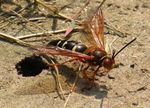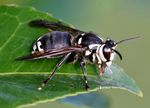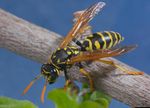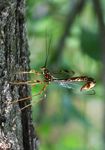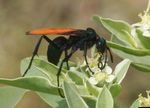Asian Giant Hornet (Vespa mandarinia Smith) - Utah Pests
←
→
Page content transcription
If your browser does not render page correctly, please read the page content below
Published by Utah State University Extension and Utah Plant Pest Diagnostic Laboratory ENT-217-20-PR May 2020
Asian Giant Hornet
(Vespa mandarinia Smith)
Lori Spears, CAPS Coordinator • Carson Wise, Extension Intern • Ryan Davis, Arthropod Diagnostician
Quick Facts
• Asian giant hornet (AGH) is an invasive wasp that
was detected in northwest Washington and British
Columbia, Canada in fall 2019 and spring 2020;
however, it is not known to be established in those
regions. It has not been detected in Utah.
• AGH is native to parts of Asia where it is common
in temperate and subtropical lowland forests.
• AGH is the world’s largest species of hornet, with a
length up to 2 inches and a wingspan of 3 inches. Figure 1. The Asian giant hornet (AGH) is the world’s largest
hornet and is about 4 times the size of a honey bee.
• AGH is a social insect that constructs large nests
that are typically located underground. of eastern Russia. AGH is best adapted to areas between
• AGH feeds primarily on large beetles, but will also the temperate and tropical zones, and is more closely
consume honey bees and other insects, spiders, associated with lowlands than high elevations. Although
as well as tree sap, nectar, honey, and soft fruits.
it has been collected at about 7,000 ft. in Myanmar and
• AGH is of concern to beekeepers because it can about 3,800 ft. in Pakistan, wasps there are rare and
quickly destroy honey bee colonies. populations occur at low densities.
• Stings can cause pain, swelling, and become life
threatening, but AGH is generally not aggressive DESCRIPTION
unless its nest or food source is disturbed.
Hornets are wasps in the genus Vespa. There is only
one other true hornet in north America, the introduced
T
he Asian giant hornet (Vespa mandarinia Smith) European hornet (V. crabro), which occurs in parts of
(Hymenoptera: Vespidae) is an invasive insect that the eastern U.S. AGH is the world’s largest hornet. Adult
was recently detected in a small area of North America. AGH workers vary in length from 1 to 1 1/2 inches, while
A single colony was found in British Columbia, Canada queens can reach up to 2 inches. They have a wingspan
in August 2019. The nest was subsequently destroyed. of about 3 inches. Adults have a large orange or yellow
In December 2019, two dead hornets were found near head, prominent eyes, orange mandibles, dark brown
the Canadian border in Washington. In spring 2020, one antennae with orange segments at the base, a dark
hornet was found in each of the above locations. Despite brown thorax, and a brown/black and yellow striped
these detections, AGH is not known to be established abdomen (the last or 6th segment is yellow) (Figs 1-4).
in North America. It has NOT been detected in Utah. Females have stingers that are about 1/4 inch long,
If you are located in Utah and suspect AGH, please whereas males are stingless. Larvae and pupae are
contact the Utah Plant Pest Diagnostic Lab at Utah State confined within the nest cavity and can be identified
University or the Utah Department of Agriculture and by their large size (compared to other hornet species).
Food. AGH’s natural distribution includes parts of Asia, Larvae are about 1 to 1 1/2 inches long, barrel-shaped,
including southern China, northern India, Japan, Korea, and yellow to white in color. Pupae closely resemble
Malaysia, Nepal, Taiwan, Thailand, and a very small part adults, with large black eyes and similar coloration.
UPPDL, 5305 Old Main Hill, Logan UT 84322, utahpests.usu.edu Page 1European hornet (Vespa crabro) is an invasive insect that
might also be confused for AGH due to its size, shape,
and color (Fig 6); however, it is currently only found in the
eastern part of the U.S.
Figure 2. AGH has prominent eyes, orange mandibles, and dark
brown antennae with orange segments at the base.
Figure 3. AGH has an orange head, dark brown thorax, and a
brown/black and yellow striped abdomen. There is a distinct
contrast between the orange head and brown thorax.
Figure 4. The last abdominal segment is yellow.
LOOKALIKES Figure 5. Lookalikes include (from top left to right, row by row)
tarantula hawk wasp (Pepsis spp.), cicada killer (Sphecius
Note that there are many other insects in Utah that may spp.), sand wasp (Bembix spp.), mud dauber (Sceliphron spp.),
be mistaken for AGH, including the tarantula hawk wasp, giant ichneumon (Megarhyssa spp.), pigeon tremex (Tremex
columba), European paper wasp (Polistes dominula), western
western cicada killer, sand wasps, mud dauber/mason/ yellowjacket (Vespula pensylvanica), bald-faced “hornet”
potter wasps, the pigeon tremex, giant ichneumon, (Dolichovespula maculata), scoliid wasp (Scolia spp.), and great
golden sand digger (Sphex ichneumoneus).
European and native paper wasps, yellowjackets, great
golden sand digger, and scoliid wasps (Fig 5). Further, the
UPPDL, 5305 Old Main Hill, Logan UT 84322, utahpests.usu.edu Page 2PREDATORY STRATEGIES
AGH feeds mostly on large beetles, but will also consume
honey bees and other insects, spiders, as well as tree sap,
nectar, honey, and soft fruits. Adults feed only on prey
or plant juices, but feed their larvae chewed-up prey.
Workers tend to forage for food within one mile from
their nest, but can fly up to about five miles. AGH attacks
honey bees and other social insects in three phases:
• Hunting Phase: An individual hornet finds and
attacks (typically at the head) a honey bee that is
Figure 6. European hornets (V. crabro) are established in parts of just outside the bee hive. The hornet then transports
the eastern U.S., but have not been detected in Utah. They are
the dismembered bee to its own nest to feed to the
slightly smaller than AGH (1 - 1 1/2 inch in length) and have an
abdomen that is mostly pale yellow with black stripes. developing brood. Before returning to its own nest, the
hornet chemically marks the bee hive.
LIFE CYCLE • Slaughter Phase: In late summer, when food sources
AGH is a social insect that lives in colonies (nests) are more scarce to feed the wasps’ large nests and
made up of one queen and her offspring. Colonies developing brood, up to 50 hornets may attack the
are established in the spring by mated queens. After marked hive. All adult bees in the colony will be killed
spring emergence, the queens locate a suitable nest within 2 hours or at the most, two days.
site while feeding on tree sap for energy. Nests are
• Occupation Phase: Hornets enter the defeated hive
typically constructed underground in pre-existing cavities
and collect the bee brood to feed their own larvae.
or burrows (Fig 7), and are often large (e.g., mature
nests may contain 1,000 or more cells). Larvae develop
PUBLIC HEALTH CONCERNS
through five instars, feeding on bits of prey or tree sap (left
for them by the queen), and eventually pupate within the AGH does not generally bother humans or pets, but it will
brood cell. The new workers then emerge and take over defend its nest or food source. They can sting repeatedly
foraging duties, while the queen continues to lay eggs. and their venom is more toxic than that of most other
Colonies grow over the summer, and new reproductive insects. Their sting has been compared to that of the
queens and males emerge in the fall (October) to mate tarantula hawk, the bullet ant, and some velvet ants that
with each other. In late fall, the founding queen dies after have some of the most painful stings in the world. AGH
which the colony diminishes in size before succumbing is most aggressive during the slaughter and occupation
to lack of worker replacement. New, mated queens phases of its attack. In Japan, 30-50 people per year
overwinter in the soil to emerge the following spring. die from AGH stings. Most deaths come in the form
of anaphylaxis and cardiac arrest; other sting victims
succumb to rare complications. If you stumble upon a
nest, calmly walk away; however, note the location of
the nest and then contact local authorities. AGH can
fly at the speed of about 20-25 MPH, so the odds of you
running to avoid it is highly unlikely. If an AGH stings you,
thoroughly wash the site with soap and water, apply ice
to prevent the venom from spreading to other parts of
the body, and take an antihistamine to reduce itching
(if necessary). Call 911 if you are stung multiple times,
Figure 7. AGH nests are typically underground. have signs of an allergic reaction (trouble breathing
or swallowing), feel faint or dizzy, or have other signs
of systemic illness. If you have known allergies to stings,
administer a shot of epinephrine with an epipen.
UPPDL, 5305 Old Main Hill, Logan UT 84322, utahpests.usu.edu Page 3Beekeepers are more likely to encounter AGH than other
REFERENCES
members of the community. The usual beekeeping suit
Government of British Columbia. 2019. Asian hornet (Vespa mandarinia).
is not thick enough to prevent AGH sting hazards. As BC Ministry of Agriculture.
a result, specialized suits are worn in Japan to prevent
Cobey, S., T. Lawrence, and M. Jensen. 2020. Asian giant hornet (Vespa
injury. The suit is multilayered and the outside material is mandarina). Washington State University Extension.
slick to prevent the hornet from holding on to the suit.
Gill, C., C. Jack, and A. Lucky. 2020. Featured creatures: Asian giant
hornet (Vespa mandarinia). University of Florida EENY-754.
MONITORING & MANAGEMENT Lee, J.X.Q. 2010. Notes on Polistes testaceicolor and Vespa mandarinia
(Hymenoptera, Vespidae) in Hong Kong, and a key to all Vespa species
AGH has not been detected in Utah. The distribution known from the SAR. Hong Kong Entomological Bulletin 2: 31-36.
of AGH in its native range occurs within plant hardiness
Matsuura, M., and S. F. Sakagami. 1973. A bionomic sketch of the giant
zones 3-13. In the U.S., all states in the lower 48 fall within hornet, Vespa mandarinia, a serious pest for Japanese apiculture. Journal
this range. However, the elevation and climate of the Of The Faculty of Science Hokkaido University Series VI. Zoology 19: 125-
162.
Intermountain West likely lies at the relative limits of what
this insect prefers ecologically (i.e., lower elevation, Salp, K. 2020. Trapping for Asian giant hornets. Washington State
Department of Agriculture.
between the temperate-tropical zone, and above zone
Suenami, S., M. Konishi Nobu, and R. Miyazaki. 2019. Community analysis of
5). If AGH did make it to Utah, they may only be a minor
gut microbiota in hornets, the largest eusocial wasps, Vespa mandarinia
part of the overall wasp community and would not take and V. simillima. Scientific Reports 9: 9830.
over urbanized areas like the European paper wasp has.
Tripodi, A. and T. Hardin. 2020. New pest response guidelines: Vespa
Knowing this, the below paragraphs are for informational mandarina Asian giant hornet. USDA APHIS PPQ.
purposes only, and will be expanded if AGH becomes Washington State Department of Agriculture. 2020. Asian giant hornet.
established in or near Utah in the future.
Washington State Department of Agriculture. 2020. Asian giant hornet fact
sheets for farmers, gardeners, hunters, hikers, and outdoor workers. AGR
A variety of traps and baits have been used in Japan to PUBs 809-830 -- 809-834 (N/3/20)
capture AGH, but their efficacy has not yet been tested
Yanagawa, Y., K. Morita, T. Sugiura, and Y. Okada. 2009. Cutaneous
in the U.S. Washington State Department of Agriculture hemorrhage or necrosis findings after Vespa mandarinia (wasp) stings
is working to locate and eradicate populations by using may predict the occurrence of multiple organ injury: a case report and
review of literature. Clinical Toxicology 45: 803-807.
bottle traps baited with rice cooking wine and orange
juice. However, please DO NOT trap for AGH if you live Image Credits
outside Washington. At this time, you have virtually no Figure 1: Yasunori Koide - Own work, CC BY-SA 4.0, https://commons.
wikimedia.org/w/index.php?curid=90136272
chance of catching AGH; instead, you will kill only local
Figures 2-4: Washington State Department of Agriculture, Washington
insects, some of which may be beneficial. Hornet traps
State Department of Agriculture, Bugwood.org
bought commercially in the U.S. will not work for AGH,
Figure 5: (from top L to R, row by row) Whitney Cranshaw, Colorado State
primarily because the entrance holes are too small.
University, Bugwood.org; Jessica Louque, Smithers Viscient, Bugwood.org;
Howard Ensign Evans, Colorado State University, Bugwood.org; Johnny
In its native range, AGH is managed using a variety N. Dell, Bugwood.org; Steven Katovich, Bugwood.org; Billmcmillan / CC
BY-SA (https://creativecommons.org/licenses/by-sa/4.0); Joseph Berger,
of strategies, including nest removal, bait traps, mass
Bugwood.org; Whitney Cranshaw, Colorado State University, Bugwood.
poisoning (using malathion), trapping hornets at bee org; Johnny N. Dell, Bugwood.org; Whitney Cranshaw, Colorado State
University, Bugwood.org; David Cappaert, Bugwood.org;
hive entrances, and using mechanical devices (e.g.,
screening or false bottom boards) to exclude hornets Figure 6: Jim Baker, North Carolina State University, Bugwood.org
from entering bee hives. Figure 7: Kim, Hyun-tae / CC BY (https://creativecommons.org/licenses/
by/4.0)
Precautionary Statement: Utah State University Extension and its employees are not responsible for the use, misuse, or damage caused by application or misapplication of products
or information mentioned in this document. All pesticides are labeled with ingredients, instructions, and risks. The pesticide applicator is legally responsible for proper use. USU makes no
endorsement of the products listed herein.
In its programs and activities, Utah State University does not discriminate based on race, color, religion, sex, national origin, age, genetic information, sexual orientation or gender identity/
expression, disability, status as a protected veteran, or any other status protected by University policy or local, state, or federal law. The following individuals have been designated to
handle inquiries regarding non-discrimination policies: Executive Director of the Office of Equity, Alison Adams-Perlac, alison.adams-perlac@usu.edu, Title IX Coordinator, Hilary Renshaw,
hilary.renshaw@usu.edu, Old Main Rm. 161, 435-797-1266. For further information on notice of non-discrimination: U.S. Department of Education, Office for Civil Rights, 303-844-5695,
OCR.Denver@ed.gov. Issued in furtherance of Cooperative Extension work, acts of May 8 and June 30, 1914, in cooperation with the U.S. Department of Agriculture, Kenneth L. White,
Vice President for Extension and Agriculture, Utah State University.
UPPDL, 5305 Old Main Hill, Logan UT 84322, utahpests.usu.edu Page 4You can also read




